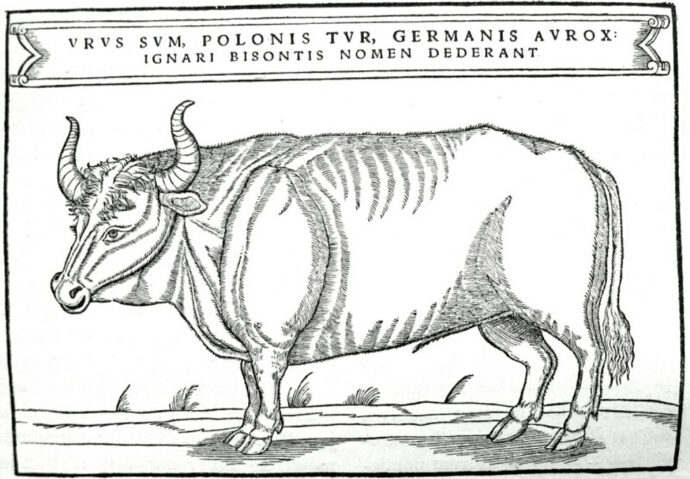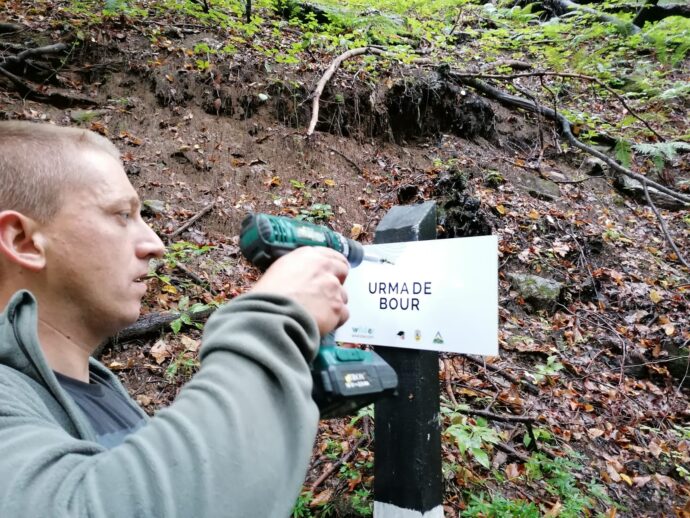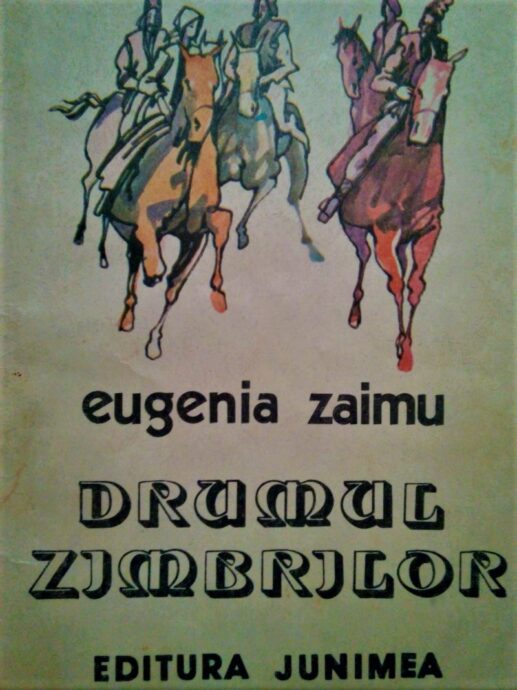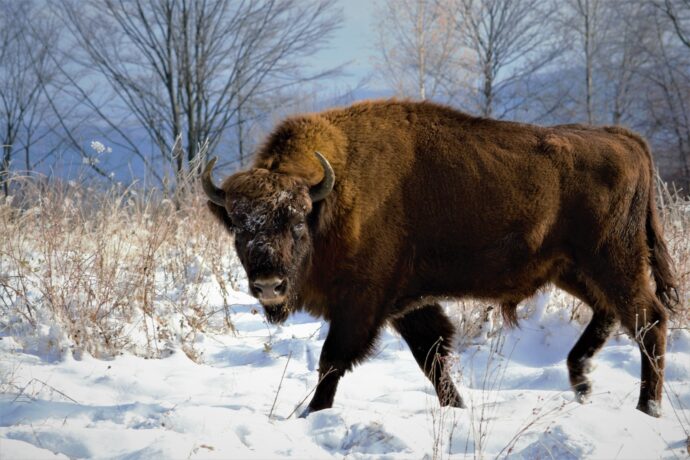Legendary bison return from the brink
The bison, a revered and respected animal in the history of Romania holds it’s ground in front of any predator, but is vulnerable to humans.
The species present in Europe for tens of thousands of years is always in danger of diminishing its population if we do not act to protect it, and thus maintain the natural balance on which we all depend.

Coliboaia Cave – bison in Paleolithic painting
Paleolithic bison
In 2010 in the Coliboaia Cave were discovered several cave paintings that can be dated between 23,000 and 35,000 years ago. It is the first time that such old parietal art is attested in Central Europe. „Black paintings”, as they are also called because of their color, represent various animals, including a bison, a horse, a feline, one or two bear heads, and two fury rhinos. This cave is located 200 km away from the first bison rewilding area in the Southern Carpathians, at the foot of the Tarcu Mountains.
Zimbrul în folclorul românesc

Auroch in an 1556 illustration
The giants that lived in Europe, such as the auroch or the bison, inspired many stories meant to celebrate great medieval leaders, to mark human settlements, or to inspire young people to undertake acts of bravery. Sometimes the species were confused in folklore, for example, the founding of Moldova is based on the legend of Dragoș Vodă who hunted bison with his dog Molda, but on the coat of arms of Moldova is an ox’s head, not a bison. Often confused with the bison, but much larger, the wild ox (Bos primigenius) was hunted by poachers until extinction, the last specimen being recorded in 1627 in Jaktorów Forest, Poland.

In Armeniș the legend of the ox trail tells us that …
“In ancient times, when evil had just appeared on earth, a spirit turned into an ox stole Armina, the beautiful daughter of a voivode. Hearing this, the shepherd to whom the girl’s hand was promised began to hunt the ox. He took out his bow and the arrow fluttered, sinking deep into the ox’s ribs. The ox knelt, stumbling. A second arrow marked the end of the spirit and Armina was saved. The two married and the place at the foot of the river where they settled was called Armeniș. The place where the ox knelt can still be seen today. ”
You can follow in Armina’s footsteps when you visit Armeniș, the route is marked and detailed on the website of the ecotourism destination Bison Hillock.
Another legend published in 1981, The road of the bison (Drumul Zimbrilor) written by Eugenia Zaimu and illustrated by Mircea Dumitrescu brought joy to the childhood of our colleague Alexandra from the Life Bison team. The book tells children about the adventure of Mihai Vodă’s army around 1600. Assaulted by their enemies, they wisely asked for help from the bison, one of them also having a special

Ilustration from the book The road of the bison.
Bison, brave warrior
Keeps the mountain on his neck
And the stars in his horns
Under the hooves the bad things
The cold river under his legs
Silky grass under the dawn
Ripe grains on the forehead
Wealth in my courtyard
Anger in the boulders
And misfortune for the enemy
May your flock live long
Bison, ancestor!…”
The bison herd invades the enemies and the army of Molodova is victorious. The brave celebrate the victory full of gratitude to the bison.

Ilustration from the legends of the bison, The Road of the bison.
Endangered species
Hunted and left without sufficient habitat, the bison disappeared from the wild in the twentieth century. The royal families of Lithuania and Poland and the Russian tzars were the only ones who still boasted bison in their forests.
From Western Europe, they have disappeared since the 11th century, and in Romania the last bison was killed in Moldova in 1762, and in Transylvania in 1790. The last bison in the wild was killed in Poland in 1919, and in the world in 1927, in the Caucasus.
By 1927, less than 50 bison had remained in zoos in Europe. A group of conservationists decided to save the species from extinction. Bison have been successfully reintroduced into the wild since 1951. The largest populations are now found in Belarus, Poland, and Russia; smaller herds also exist in Lithuania, Ukraine, and Kyrgyzstan.
From myth to reality
In Romania, the first bison were reintroduced in the Vânători Neamț National Park in 2012. There are now 47 free bison in this park. In the Făgăraș Mountains, the Conservation Carpathia Foundation introduced 13 bison, the objective being the release of 100 specimens in this area.
Today, the largest population of bison is between 63-67 specimens and is located in the Țarcu Mountains. Bison have been brought from reserves and breeding centers in Europe following a complex selection process to ensure genetic diversity. The objective of the long-term project initiated in 2014 by Rewilding Europe and WWF Romania is to create a viable population that breeds in the wild and helps the growth of both biodiversity and sustainable entrepreneurship ideas based on ecotourism for local communities to develop sustainably.
The presence of a stable population of bison contributes to the maintenance of a mosaic structure in the landscape, by consuming the excess vegetation from the forest openings, meadows, and forested meadows. As the diversity of the landscape and vegetation increases, enclaves are created that are suitable for the spread of other species of invertebrates, birds, small mammals. Restoring the bison population in the southwestern Carpathians will bring the major ecological benefit of having an umbrella species here. This term refers to a species that needs the best environmental conditions over a large area; these conditions are also favorable to other species. Thus, the bison conservation program is implicitly a conservation tool for other specie, on a large scale in this region.

Free bison male in the Bison Hillock, Armeniș
Supraviețuirea zimbrilor
People have always been attracted by the greatness of bison, and Romanians can once again be proud of the richness of nature that they are surrounded with. Romania is an example of the entire continent. It’s history, culture and nature are unique and necessary for future generations to enjoy and learn from.
The community in the area called Măgura Zimbrilor benefits from bison rewilding through the development of ecotourism. It can bring a new source of income, but also keep young people in their birthplaces where they can grow prosperous and sustainable businesses.
Human-bison coexistence is a priority for the project team and local authorities who support each other in developing proactive solutions that ensure a harmonious relationship with bison.
Together we can make sure bison will persist in secular forests and lives, not just in our legends. Be informed about the bison population in Romania, follow the site life-bison.com
The reintroduction of bison in the Southern Carpathians is carried out within the project “Urgent actions for the restoration of bison populations in Romania”, implemented by WWF Romania and Rewilding Europe, with financial support from the European Union, through the LIFE Programme and with local communities.
- Find ou more about human-wildlifecoexistance actions
- Visit the rewilding are with tailored expeditions by Europene Safari or WeWilder
- Follow the action on in the field on the LIFE Bison Facebook page Rewilding Southern Carpathians
Bibliografy
Historia, Cele mai vechi picturi paleolitice din Europa Centrală, descoperite la Bihor -https://www.historia.ro/sectiune/actualitate/articol/cele-mai-vechi-picturi-paleolitice-din-europa-centrala-descoperite-in-bihor
Zaimu, Eugenia [1981] Drumul Zimbrilor, București: Editura Junimea
Zimbrul – https://ro.wikipedia.org/wiki/Zimbru
Aurochs – https://en.wikipedia.org/wiki/Aurochs
Conservation Carpathis, Munții Făgăraș devin acasă pentru zimbri – https://www.carpathia.org/ro/muntii-fagaras-devin-acasa-pentru-zimbri/
Parcul Național Vânători-Neamț, Zimbrul – http://vanatoripark.ro/
Măgura Zimbrilor, În Natură, Pe urmele legendelor – https://bisonhillock.ro/ecotourism/trails/nature-trails/
IUCN Red List, Bison – https://www.iucn.org/commissions/ssc-groups/mammals/mammals-a-e/bison
Blog entries express the views and opinions of their authors, which might not always fully overlap with those of Rewilding Europe.